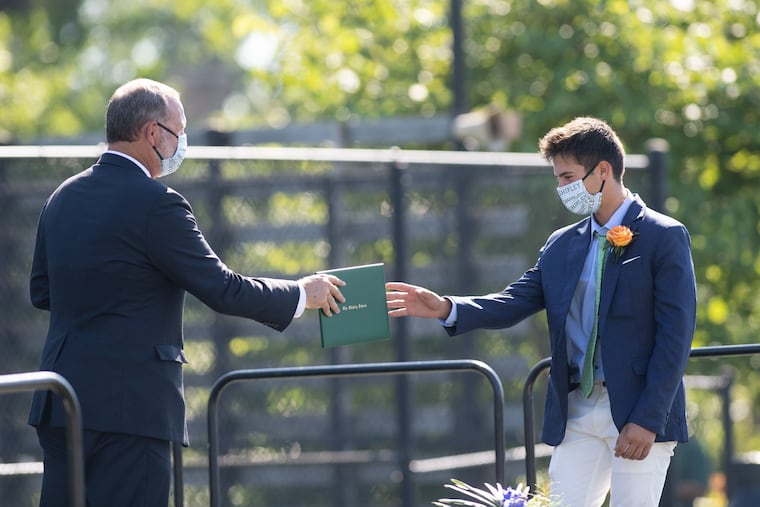At the elite Shipley school in Bryn Mawr, money is no object in coronavirus-reopening plans | Maria Panaritis
This elite Main Line private school is doing what public schools cannot: Give its wealthy students a premium education, pandemic be damned.

For the price of $24,000 to $40,000 per child in tuition, here is how one of the most prestigious private schools in suburban Philadelphia is planning to get around the problem of a coronavirus pandemic that is forcing the shutdown of in-class instruction at many public schools this fall.
Spoiler alert: The kids get to go to class. In person. Every single day of the week.
The Shipley School is aiming for this lofty outcome through a staggering array of if-then statements and contingency plans shared with me a few days ago by head of school Michael Turner. By the end of our one-hour-long talk, it felt as though I had just interviewed a logistics chief of a major corporation.
Every education administrator has been scrambling. But only a few have the resources of a place like Shipley, a fact that in and of itself, is both breathtaking and distressing.
“This is incredibly expensive,” Turner said when asked how Shipley was underwriting an elaborate, labor-intensive plan to pull off what even well-funded suburban districts like Lower Merion are refusing to do on Day One: in-person instruction, five days a week.
While school districts buckle under pandemic pressures, tight budgets, and few of the facilities or wiggle room of a place like Shipley, we see money at this Main Line school buying well-heeled students a premium alternative. Shipley is not serving up the kind of masking-tape-and-cyber-patchwork being concocted by desperately overburdened public schools this fall.
In just the last couple of weeks, a number of districts as prominent as Lower Merion’s have told parents their children will start the school year at home. So what if you and your husband work? So what if the kids are 9 and 10 years old or in kindergarten or gunning for college? Details are scant and have been all summer.
Shipley, meanwhile, is sparing no expense to do the opposite.
They are buying web cameras to beam live classes home for anyone who wants to learn virtually. The school also is trimming further its already small class sizes and capping them at 9, 10, or 11 students, vs. 15 in a normal year for second grade. The goal is to facilitate enough social distancing to prevent the spread of the coronavirus. It is hiring more teachers and staff because of that strategy.
Plastic-glass shields are already on campus. Up to 10 huge tents for extra classroom space will be erected on athletic fields so vast that, as I viewed the turf during a recent visit, the sheer acreage made Citizens Bank Park seem small.
Turner, the head of school for about a year, said preparations had been tough.
“Our team, people haven’t had a day off since winter break,” he said.
If someone tests positive for COVID-19, there are several scenarios for how to stay open or modify operations, including quarantining classes and rotating teachers. There will be no testing, however, by the school. This, of course, is the great wild card facing everyone.
It is no surprise that Shipley, a storied bastion of Main Line elites, is doing so much to beat back the pandemic. I had called, in fact, to gauge exactly what was possible when money is, effectively, no object.
If only we could say the same for all our children, all our families, all our schools.
Shipley even is looking for ways to possibly help its own teachers who may have young children stranded at home due to their own public schools planning virtual-only instruction.
“We’re trying to understand the scope of that issue,” Turner said, “and exploring options.”
Shipley has expanded its leave policies for faculty concerned about their health, is offering accommodations to others, and has been walking teachers through modified classrooms and procedures to make them feel safe.
“At the end of the day it doesn’t matter how much planning we do,” Turner said. “Our faculty is the most important part of our program in meeting our mission. If we don’t take good care of our colleagues, then we don’t have a school. All the Plexiglas barriers in the world don’t replace teachers.”
God bless Shipley. Money, as we know, fixes a lot of problems in this country, and Shipley’s got it. Its board even put together a fund to help students whose parents may have fallen on hard times with the pandemic recession.
But God help the school districts at which destruction is the order of the day. Those resorting to virtual-only teaching are eliminating contagion risk at their schools but offloading it onto parents who must now hire caregivers and tutors to enter their homes if mom and dad have jobs they can’t afford to quit.
Shipley intends to stay open for in-the-flesh learning for its roughly 770-and-counting prekindergarten-through-12th-grade students (enrollment numbers are still in flux) as long as Gov. Tom Wolf does not impose shutdown orders.
“Five days a week for a full school day for any student that wants to come to school,” Turner said. “We will give families the option to learn on campus or remotely, and to move back and forth fluidly between those two models. If your child wants to come to school Monday and learn online Tuesday, OK. Families don’t need to tell us that.”
These are the fault lines in America 2020. Money talks — now more than ever.